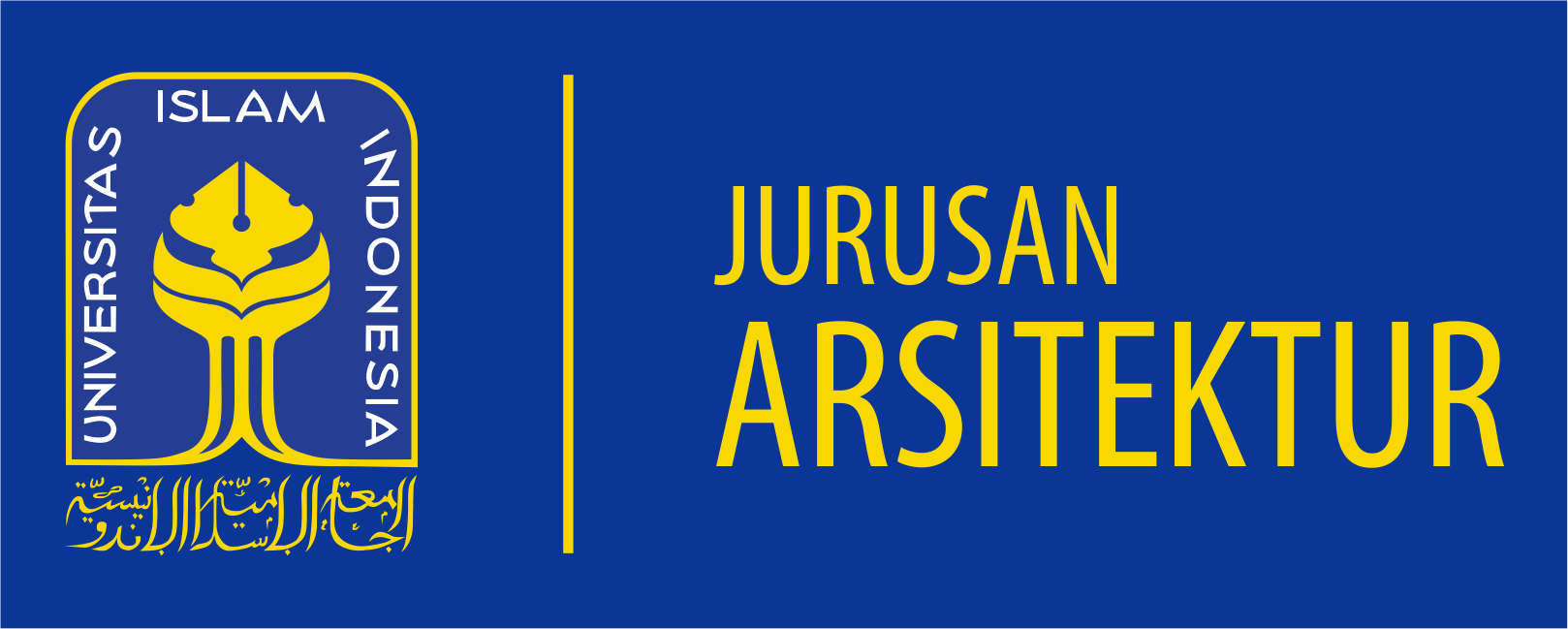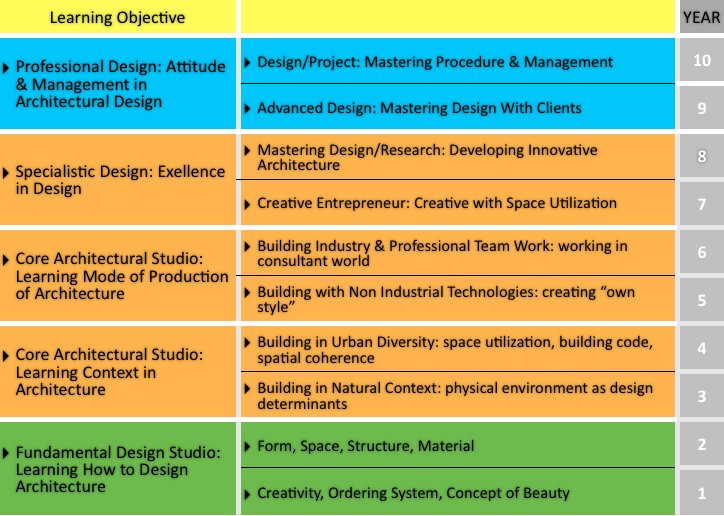History of the Curriculum
HISTORY OF CURRICULUM DEVELOPMENT
To achieve competence of the graduates as formulated above, Department of Architecture UII develop curriculum as the fundamental design for learning content and process. Since its establishment in 1987, the Department have implemented 5 curriculums, which are Curriculum 1987, 1995, 2002, 2008, dan 2013. These Curriculums are desugned with primary concerns towards professionalism and international recognition based on local tradition and Islamic values. The variety of approaches and references in achieving professionalism and international recognition gives the characteristics of these Curriculums.
As a newly-established institution, Department of Architecture UII was under the supervision of Department of Architecture Gadjah Mada University. Consequently, its Curriculum was developed following the model of its supervising institution with some additional courses on Islamic values. The first Curriculum of Department of Architecture UII consists of 71 courses, compulsory and elective, distributed in 9 semester. It has 8 Architectural Design Studio courses consecutively delivered in all semester ending with Final Project in semester 9.
Table History of Curriculum in Department of Architecture UII
|
1987 CURRICULUM |
1995 CURRICULUM |
2002 CURRICULUM |
2008 CURRICULUM |
2013 CURRICULUM |
|
First Curriculum following UGM model with some addition on Islamic values (9 semesters) |
Comprehensive Professional Orientations (with 4 studios in the 7th semester) |
Building design as primary competence Consideration of NAAB SPCs by distributin g these criteria into courses |
Further consideration of NAAB SPCs Integration of courses into studios with larger number of credits (more than 45% of total courses) to follow RIBA pattern |
Consideration of KAAB SPCs and other KAAB requirements. |
The first Curriculum “genuinely” developed by Department of Architecture UII is implemented in 1995. It is oriented towards professionalism as a broad field to study. This Curriculum has 58 courses delivered in 8 semester. Three Studio courses are given at semester 7 or the last semester prior to Final Project. Architectural Design Studio, being the primary studio has 8 credits. Other two supporting studio courses are Urban Design Studio and Urban Planning and Housing Studio, each has 4 credits, to extend the ability of the students in designing and planning in these related fields.
Indonesian Association of Schools of Architecture (IASA) is founded in 2001 with Department of Architecture UII as one of its founding member. IASA produce guidelines to implement the Minister of National Education Regulation concerning Curriculum Development in Higher Education. These guidelines suggest that the Curriculum should: a. have well defined graduates’ competence, b. referring the department quality assurance, c. referring to national regulation, d. directing towards international recognition, and f. resulting from harmonization among higher education, society and graduates.
By the time these regulation and guidelines are issued, Department of Architecture UII is reviewing its Curriculum. To comply with these rules, the Department implement the first point of the guidelines by formulating graduates competence focusing on the ability to design building rather than having studios on urban design, housing and urban planning as in the ongoing Curriculum 1995.
During Curriculum review to be implemented in 2002, Department of Architecture UII also aspire towards internalization. It refer, therefore, to international accrediting body guidelines to formulate the competence of the graduates and the content of the Curriculum. The referred guidelines are those formulated by National Architectural Accreditation Board (NAAB) of the United States of America. All of the 37 competences as stipulated in NAAB regulation are implemented in 59 courses delivered in 8 semesters. These regulation also shape further the detailed competences of the graduates of Department of Architecture UII which are described as:
a.Knowledge on tradional architecture and history of Indonesian and Western architecture
b.Understanding the framework of architectural knowledge and architectural research method and skills
c.Having the abilty for computer-supported design, and presentation skills
d.Understanding the principles of sustainable development
e.Understanding human behavior, human diversity, accessibily and building economics as design considerations
f.Having Islamic professional ethics and entrepreneurship spirit
g.Having the ability to work independently and in team, critical attitude and long-life learning
All design studio courses in this Curriculum deal with architectural design in the building scale. Stages of development of these Architectural Design Studio courses are formulated to start from a single architectonic composition in Semester 1 to a mid-size building in a particular urban context in Semester 7 prior to Final Project. Variety of contexts and design approaches are also distributed in these studio courses to cover the whole competence in the level of ability as stipulated in NAAB rules.
In developing Curriculum 2008, Department of Architecture UII take further step towards internationalization by inviting an international reviewer, a professor from Department of Architecture National University of Singapore (NUS). As architect’s professional program in NUS is fully accredited by Royal Institute of British Architects (RIBA), in this occasion Curriculum of UII is reviewed based on criteria and guidelines as stipulated by RIBA and implemented in NUS.
In general, the content of the previous Curriculum complies with the requirement of RIBA. In terms of proportion, however, RIBA requires that the number of credit of all studio courses should comprise at least 50% of all the credits in the Curriculum.
To achieve the required proportion of studio course credits, Architectural Design Studio courses are given more credits by integrating this subjects with other practically oriented courses resulting in the proportion of 45% credits are allocated for studio courses. Consequently, the number of courses are reduced from 59 in the previous Curriculum to 41 in Curriculum 2008.





Leave a Reply
Want to join the discussion?Feel free to contribute!